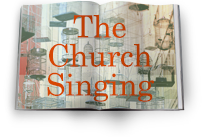9 Choices for a Healthy Music Ministry
Editor’s note: This article is a follow-up to yesterday’s «In Praise of Low-Budget, Non-Professional Music Ministries.»
* * * * *
If you were to join us at the Capitol Hill Baptist Church, in Washington, D C, for our average Sunday morning service, what would you notice about our music? I’m not sure, but I would like to point out several choices that we’ve made, that I think contributes to the healthy constraint and expression of music in our congregation.
1) PRIORITY
Nowhere in the New Testament are local churches commanded to have “background” music during times of mingling or taking up the offering. Though the redeemed will form a choir in eternity, some Christians listening to a subset of their number sing is nowhere commanded or exampled in New Testament churches. Performed music is not commanded; however, congregational singing is.
For us, this means the question of whether there is performed music in the service is a question of whether it edifies the congregation, whether that edification is worth the time taken up in preparation, and taken from other elements of the service when it’s performed. We give a clear priority to spending time in the service singing together, considering what will help us to do that better.
2) SEATING
One of the most striking things you might notice would be that our building was designed originally in a way that did not focus the congregation’s gaze down the long aisle of a rectangular auditorium to a pulpit and platform at the far end of the room. Rather, the building has a main hall that is about quarter of a circle, both on main floor and in its balcony. When the old “Sunday School Auditorium” is added by opening large doors, our congregation takes the shape a full semi-circle (and a little more).
This can be challenging for the preacher, but for the congregation and its singing, this more circular set-up is wonderful and encouraging. We are in some senses visibly singing to each other when we sing. If you have a building that doesn’t encourage this as much, you can still bring up the idea of the goodness of looking around and singing to each other, as well as to the Lord, when you sing.
3) ARCHITECTURE
We’re also helped by having an old building, one that’s particularly friendly to a congregational focus. Often, more modern facilities are more like a TV studio, with sound-dampening techniques used to quiet the sound of the congregation, while at the same time making sure all the sound from “up front” can easily be heard by everyone. But our older architecture—especially the flat ceiling!—means that the whole congregation can more easily be heard. This encourages congregational singing. If your church has a building that’s nothing like this, consider addressing some of these issues to help your congregation be able to hear each other better (for example: you could remove sound-absorbing acoustical tiles and carpet)
4) NOTES
We generally print both the words and the music of the hymns and songs we sing. This means the 10–20% of the congregation who can read music can learn new songs more quickly. And their singing helps the rest of the congregation learn the music after them. Families may use the music to help them later that day play the hymn on a piano or a guitar, so the music becomes more embedded into the life of the church.
5) PARTS
We also prefer songs and hymns that have good harmony for the congregation to sing. Like the ability to read music, most of the congregation may not know how to sing alto, tenor, or bass. But some will. And others will learn from them. We tend to sing the first stanza without parts, in unison, to help anyone who may not know the melody. Then, on the second stanza, those of us who are able will break into parts. This gives a depth and richness to the sound of the congregation’s singing that reinforces the words.
6) A CAPPELLA
Often, we’ll sing a cappella—without any instrumental accompaniment—on the final stanza. Such singing used to be more common among Protestants. If we were in the normal Sunday gathering of John Calvin in 16th century Geneva, or C. H. Spurgeon in 19th century London, there would have been no instruments accompanying the singing of the congregation. We don’t understand that the use of such accompaniment is wrong, but we do understand the power of unaccompanied human voices singing together. The final stanza of a hymn is often a climactic time where the words “pop” as the congregation hears only their own voices singing the words to the Lord and to each other. This is perhaps the most single commented-upon aspect of our service, at least by the visitors who speak to me afterwards.
7) LEADERS
It’s important that the pastors visibly sing. We shouldn’t be coolly disengaged from the service, working on our remarks, chatting with someone else, waiting in some room “off stage” to appear. We’re with the congregation as those who are most fundamentally one of them, needing God’s Word as it is ministered to us throughout the whole service, including the music. We get the wonderful opportunity to lead by example.
8) ACCOMPANIMENT
Mere accompaniment often works best for facilitating congregational singing. By “mere,” I mean simple arrangements, modest volume, and limited instrumentation. The musical excellence we aim for should be more in the congregation than in the instrumentalists or vocalists who lead or accompany our singing. We only want instruments that will help us to be able to sing. We’re not looking for them to rival—and certainly not to replace—the corporate singing of the whole congregation. Whether an electric band or an organ, a choir or a soloist, these elements are, at best, the seasoning which brings out the flavor of the congregation’s singing. They should never overpower it.
9) SELECTION
We deliberately want to use old and new hymns. We want psalms set in various musical styles. All we ask is that all of what we sing has true words and singable music! On that latter point, there’s often some subjective disagreement about which songs are in fact singable—especially before we first try them. But that the songs should be singable, no one disagrees.
Furthermore, we want to sing songs that fit the sermon text. If we’re going to be hearing about heaven, we want to prepare our hearts by singing about heaven. If we’re going to be thinking about the atonement, we’ll sing by confessing our sins, our need, and God’s provision for us in Christ. The songs should be selected to fit the sermon.
CONCLUSION
These are nine aspects of our singing that I might point out to you, if you stood next to me on Sunday morning. I hope this article—and the one before it—is helpful to you as you think about this wonderful ministry of music that your local church is called to have.









